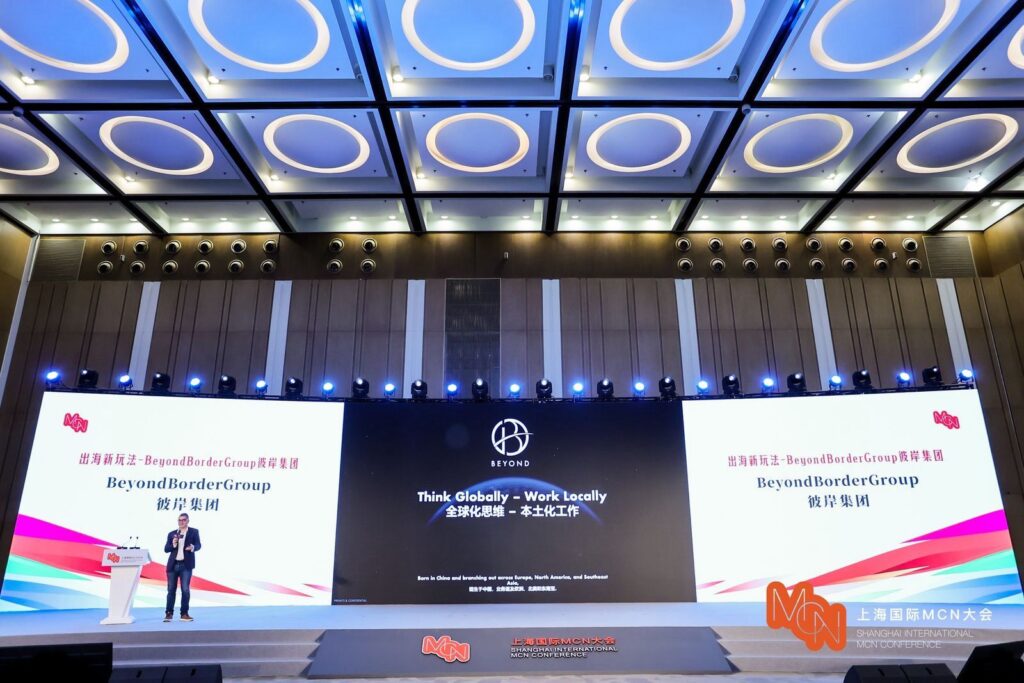Table of Contents
Our CEO was interviewed during the last MCN International conference in Shanghai last month, discussing key topics like live broadcast commerce, brand localization, KOLs, and cross-border eCommerce challenges and opportunities.
Introduce yourself
My name is Cyril Drouin, a French national who has lived in China for many years. After spending seven years as the CEO of Publicis China, where I led initiatives in commerce, performance marketing, and creative work, I founded a cross-border agency called BeyondBorderGroup. Our agency focuses on helping Chinese brands expand internationally while supporting global companies entering the Chinese market. We offer a comprehensive range of services, including branding, content creation, social media management, media planning, public relations, exhibitions, distribution, logistics, and more.

What do you think about the live broadcast economy, in China and internationally?
The live broadcast economy in China is significantly more commerce-driven compared to the West. In China, most livestreams are transactional, focusing on eCommerce or gifting. However, in Europe and the United States, direct sales through livestreams are still seen as more complex and less intuitive for shoppers. For example, Amazon Live has yet to gain substantial traction, and the sales generated are relatively low. Instagram and Facebook live sessions also struggle to drive meaningful traffic to eCommerce. Shopify, for instance, does not include live commerce as a standard feature in its basic offering, which highlights the difference in adoption rates between these regions.
Can you share your experience of localizing international brands in China?
In recent years, we have worked on localizing beauty, food, and furniture brands for the Chinese market. The initial steps always involve creating a localized Chinese brand name and logo, adapting brand assets such as photos and videos, setting up social media and eCommerce accounts, and launching initial campaigns with Key Opinion Leaders (KOLs). Beyond these fundamentals, a brand must have a compelling story and a well-defined market niche in China to be successful. Without these elements, the cost of acquiring customers becomes unsustainable for long-term growth. The brands that succeed in China often share certain characteristics: they offer a unique product that is difficult to replicate, they have a strong brand legacy, they set clear Gross Merchandise Value (GMV) and profitability goals, and they have a well-thought-out five-year growth plan.

What is the key to overseas branding?
The key to successful overseas branding lies in localization and market exposure. Localization involves developing a local brand name, adapting product or service assets to suit the local market, and working with appropriate partners. Relying solely on a Chinese partner to enter Western markets such as the United States or Germany is not effective—you need partners with teams both in China and on the ground in the target market. While Chinese origins are not always positively perceived in all markets, focusing on the product’s strengths in your marketing and communication can help. Western markets are also costly, and the business landscape is different. For instance, in the United States, there is little room for negotiation on payment terms with media platforms. Understanding these market-specific dynamics is crucial to avoid expensive missteps.
How do you see the role of KOLs evolving in both Chinese and international markets?
The role of Key Opinion Leaders (KOLs) in China remains crucial for brand success, but their involvement is changing. In China, KOLs are moving beyond simple endorsements; they are becoming integral to product development and brand strategy. Brands collaborate with KOLs early in the product lifecycle to co-create items that resonate directly with their audiences. In contrast, influencer marketing in Europe and the United States is still developing. In these markets, influencers are not yet as embedded in the commerce cycle as they are in China. However, as live commerce gains traction in the West, we may see influencers taking on a more active role in driving sales, similar to their Chinese counterparts.
What are some of the major challenges that brands face when expanding from China to Western markets?
The major challenges for brands expanding from China to Western markets include cultural differences, regulatory requirements, and variations in consumer behavior. Brands often underestimate how different Western markets are from China. The marketing approach that works well in China—typically fast-paced and high-energy—often needs adjustment to appeal to Western audiences. Navigating regulatory requirements also presents significant challenges, including dealing with differences in data privacy laws, product certifications, and advertising standards, all of which require deep local knowledge. Additionally, Chinese brands often face perception issues in Western markets. To compete effectively against well-established legacy brands, Chinese companies must focus on building trust and delivering high-quality products that meet Western standards.

How do you envision the future of cross-border eCommerce evolving in the next five years?
In the next five years, I anticipate a convergence of eCommerce approaches across different regions. China’s influence on Western eCommerce trends is evident—livestream commerce, super apps, and social shopping are already gaining popularity in the West. At the same time, Chinese companies are learning from Western practices, focusing more on branding and creating experience-driven sales. We can expect to see more seamless integration of commerce within social media platforms, increased use of artificial intelligence to provide personalized shopping experiences, and a greater emphasis on sustainability. Consumers are becoming increasingly conscious of the origins and production methods of the products they purchase, and brands that align with these values will have a distinct advantage. Cross-border eCommerce will evolve beyond simply entering new markets to creating a truly integrated global shopping experience.

